dashboard Alfa Romeo 8C 2009 Owner handbook (in English)
[x] Cancel search | Manufacturer: ALFA ROMEO, Model Year: 2009, Model line: 8C, Model: Alfa Romeo 8C 2009Pages: 223, PDF Size: 14.35 MB
Page 16 of 223
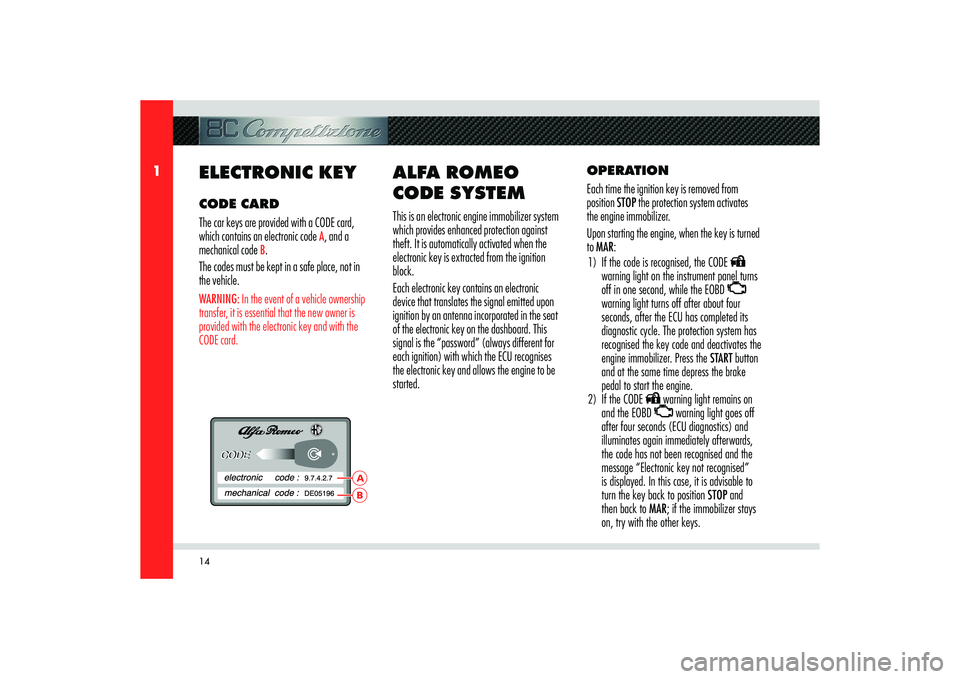
14
1
BA
ELECTRONIC KEYCODE CARD
The car keys are provided with a CODE card,
which contains an electronic code
A, and a
mechanical code
B.
The codes must be kept in a safe place, not in
the vehicle.
WARNING: In the event of a vehicle ownership
transfer, it is essential that the new owner is
provided with the electronic key and with the
CODE card.
ALFA ROMEO
CODE SYSTEMThis is an electronic engine immobilizer system
which provides enhanced protection against
theft. It is automatically activated when the
electronic key is extracted from the ignition
block.
Each electronic key contains an electronic
device that translates the signal emitted upon
ignition by an antenna incorporated in the seat
of the electronic key on the dashboard. This
signal is the “password” (always different for
each ignition) with which the ECU recognises
the electronic key and allows the engine to be
started.OPERATION
Each time the ignition key is removed from
position STOP the protection system activates
the engine immobilizer.
Upon starting the engine, when the key is turned
to MAR:
1) If the code is recognised, the CODE
warning light on the instrument panel turns
off in one second, while the EOBD
warning light turns off after about four
seconds, after the ECU has completed its
diagnostic cycle. The protection system has
recognised the key code and deactivates the
engine immobilizer. Press the START button
and at the same time depress the brake
pedal to start the engine.
2) If the CODE warning light remains on
and the EOBD warning light goes off
after four seconds (ECU diagnostics) and
illuminates again immediately afterwards,
the code has not been recognised and the
message “Electronic key not recognised”
is displayed. In this case, it is advisable to
turn the key back to position STOP and
then back to MAR; if the immobilizer stays
on, try with the other keys.
Page 25 of 223
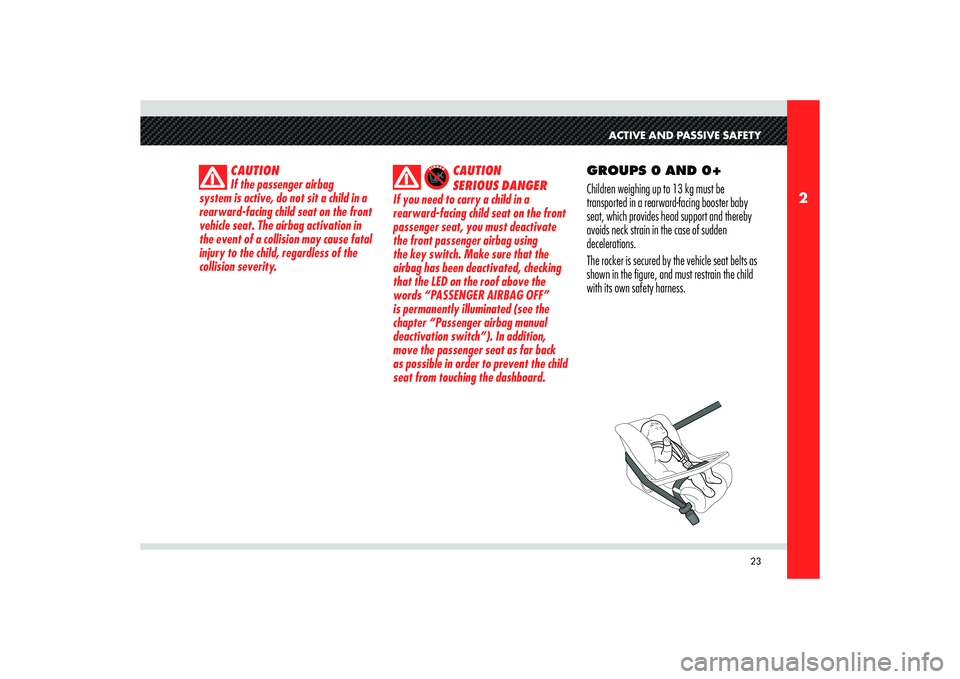
23
2
ACTIVE AND PASSIVE SAFETY
CAUTION
If the passenger airbag
system is active, do not sit a child in a
rearward-facing child seat on the front
vehicle seat. The airbag activation in
the event of a collision may cause fatal
injury to the child, regardless of the
collision severity. CAUTION
SERIOUS DANGER
If you need to carry a child in a
rearward-facing child seat on the front
passenger seat, you must deactivate
the front passenger airbag using
the key switch. Make sure that the
airbag has been deactivated, checking
that the LED on the roof above the
words “PASSENGER AIRBAG OFF”
is permanently illuminated (see the
chapter “Passenger airbag manual
deactivation switch”). In addition,
move the passenger seat as far back
as possible in order to prevent the child
seat from touching the dashboard.
GROUPS 0 AND 0+
Children weighing up to 13 kg must be
transported in a rearward-facing booster baby
seat, which provides head support and thereby
avoids neck strain in the case of sudden
decelerations.
The rocker is secured by the vehicle seat belts as
shown in the figure, and must restrain the child
with its own safety harness.
Page 30 of 223
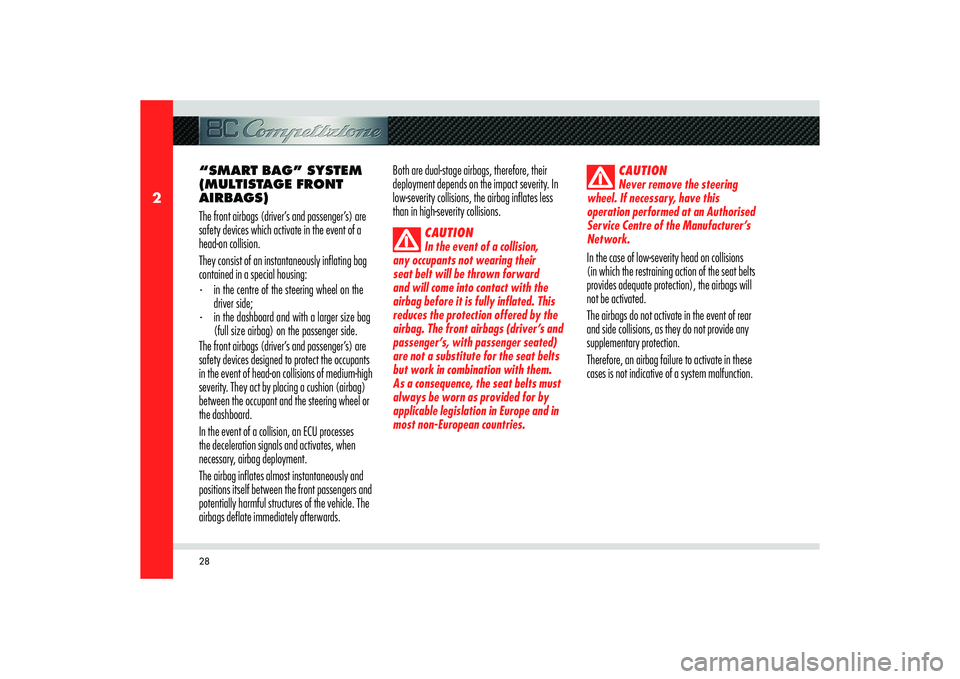
28
2
CAUTION
Never remove the steering
wheel. If necessary, have this
operation performed at an Authorised
Service Centre of the Manufacturer’s
Network.
In the case of low-severity head on collisions
(in which the restraining action of the seat belts
provides adequate protection), the airbags will
not be activated.
The airbags do not activate in the event of rear
and side collisions, as they do not provide any
supplementary protection.
Therefore, an airbag failure to activate in these
cases is not indicative of a system malfunction. “SMART BAG” SYSTEM
(MULTISTAGE FRONT
AIRBAGS)
The front airbags (driver’s and passenger’s) are
safety devices which activate in the event of a
head-on collision.
They consist of an instantaneously inflating bag
contained in a special housing:
- in the centre of the steering wheel on the
driver side;
- in the dashboard and with a larger size bag
(full size airbag) on the passenger side.
The front airbags (driver’s and passenger’s) are
safety devices designed to protect the occupants
in the event of head-on collisions of medium-high
severity. They act by placing a cushion (airbag)
between the occupant and the steering wheel or
the dashboard.
In the event of a collision, an ECU processes
the deceleration signals and activates, when
necessary, airbag deployment.
The airbag inflates almost instantaneously and
positions itself between the front passengers and
potentially harmful structures of the vehicle. The
airbags deflate immediately afterwards.Both are dual-stage airbags, therefore, their
deployment depends on the impact severity. In
low-severity collisions, the airbag inflates less
than in high-severity collisions.
CAUTION
In the event of a collision,
any occupants not wearing their
seat belt will be thrown forward
and will come into contact with the
airbag before it is fully inflated. This
reduces the protection offered by the
airbag. The front airbags (driver’s and
passenger’s, with passenger seated)
are not a substitute for the seat belts
but work in combination with them.
As a consequence, the seat belts must
always be worn as provided for by
applicable legislation in Europe and in
most non-European countries.
Page 31 of 223
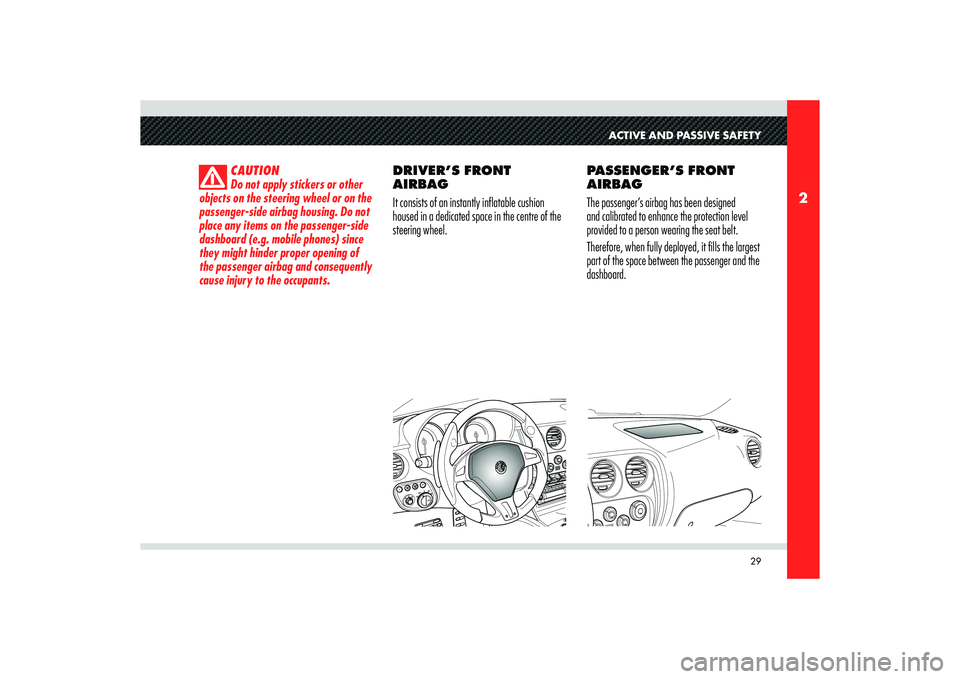
29
2
ACTIVE AND PASSIVE SAFETY
CAUTION
Do not apply stickers or other
objects on the steering wheel or on the
passenger-side airbag housing. Do not
place any items on the passenger-side
dashboard (e.g. mobile phones) since
they might hinder proper opening of
the passenger airbag and consequently
cause injury to the occupants.
DRIVER’S FRONT
AIRBAG
It consists of an instantly inflatable cushion
housed in a dedicated space in the centre of the
steering wheel.PASSENGER’S FRONT
AIRBAG
The passenger’s airbag has been designed
and calibrated to enhance the protection level
provided to a person wearing the seat belt.
Therefore, when fully deployed, it fills the largest
part of the space between the passenger and the
dashboard.
Page 32 of 223
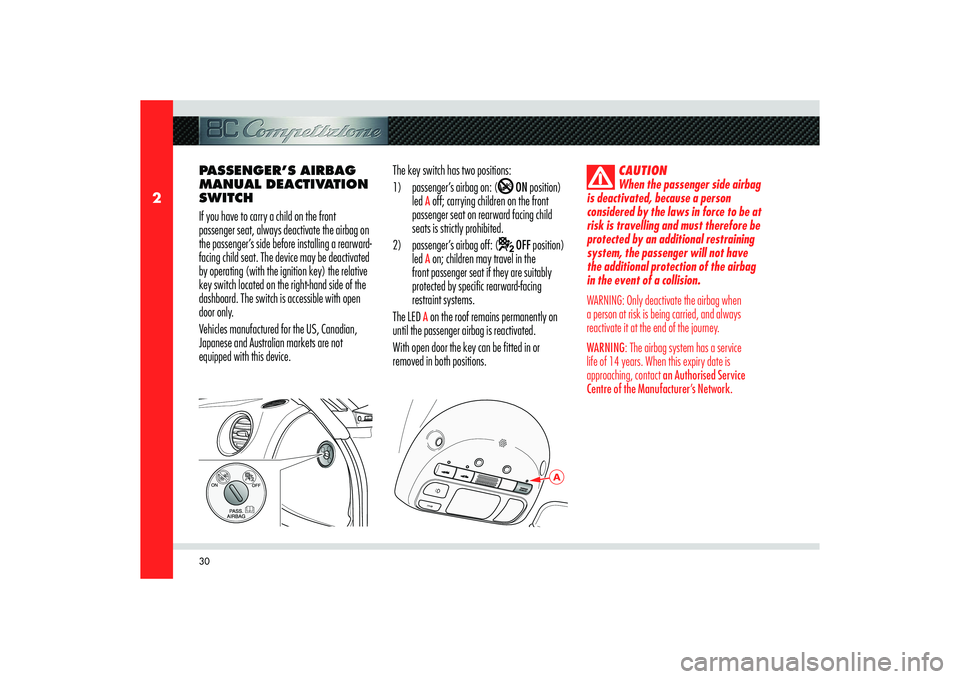
30
2
A
PASSENGER’S AIRBAG
MANUAL DEACTIVATION
SWITCH
If you have to carry a child on the front
passenger seat, always deactivate the airbag on
the passenger’s side before installing a rearward-
facing child seat. The device may be deactivated
by operating (with the ignition key) the relative
key switch located on the right-hand side of the
dashboard. The switch is accessible with open
door only.
Vehicles manufactured for the US, Canadian,
Japanese and Australian markets are not
equipped with this device.The key switch has two positions:
1) passenger’s airbag on: (
ON position)
led
A off; carrying children on the front
passenger seat on rearward facing child
seats is strictly prohibited.
2) passenger’s airbag off: (
OFF position)
led
A on; children may travel in the
front passenger seat if they are suitably
protected by specific rearward-facing
restraint systems.
The LED A on the roof remains permanently on
until the passenger airbag is reactivated.
With open door the key can be fitted in or
removed in both positions.
CAUTION
When the passenger side airbag
is deactivated, because a person
considered by the laws in force to be at
risk is travelling and must therefore be
protected by an additional restraining
system, the passenger will not have
the additional protection of the airbag
in the event of a collision.
WARNING: Only deactivate the airbag when
a person at risk is being carried, and always
reactivate it at the end of the journey.
WARNING: The airbag system has a service
life of 14 years. When this expiry date is
approaching, contact an Authorised Service
Centre of the Manufacturer’s Network.
Page 34 of 223
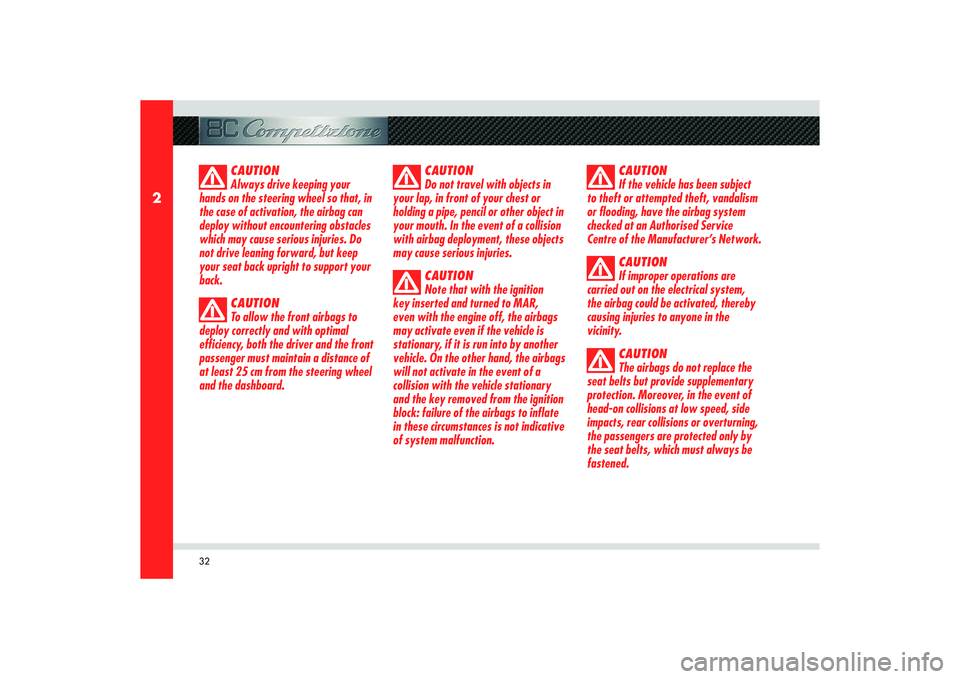
32
2
CAUTION
Always drive keeping your
hands on the steering wheel so that, in
the case of activation, the airbag can
deploy without encountering obstacles
which may cause serious injuries. Do
not drive leaning forward, but keep
your seat back upright to support your
back.
CAUTION
To allow the front airbags to
deploy correctly and with optimal
efficiency, both the driver and the front
passenger must maintain a distance of
at least 25 cm from the steering wheel
and the dashboard.
CAUTION
Do not travel with objects in
your lap, in front of your chest or
holding a pipe, pencil or other object in
your mouth. In the event of a collision
with airbag deployment, these objects
may cause serious injuries.
CAUTION
Note that with the ignition
key inserted and turned to MAR,
even with the engine off, the airbags
may activate even if the vehicle is
stationary, if it is run into by another
vehicle. On the other hand, the airbags
will not activate in the event of a
collision with the vehicle stationary
and the key removed from the ignition
block: failure of the airbags to inflate
in these circumstances is not indicative
of system malfunction.CAUTION
If the vehicle has been subject
to theft or attempted theft, vandalism
or flooding, have the airbag system
checked at an Authorised Service
Centre of the Manufacturer’s Network.
CAUTION
If improper operations are
carried out on the electrical system,
the airbag could be activated, thereby
causing injuries to anyone in the
vicinity.
CAUTION
The airbags do not replace the
seat belts but provide supplementary
protection. Moreover, in the event of
head-on collisions at low speed, side
impacts, rear collisions or overturning,
the passengers are protected only by
the seat belts, which must always be
fastened.
Page 43 of 223
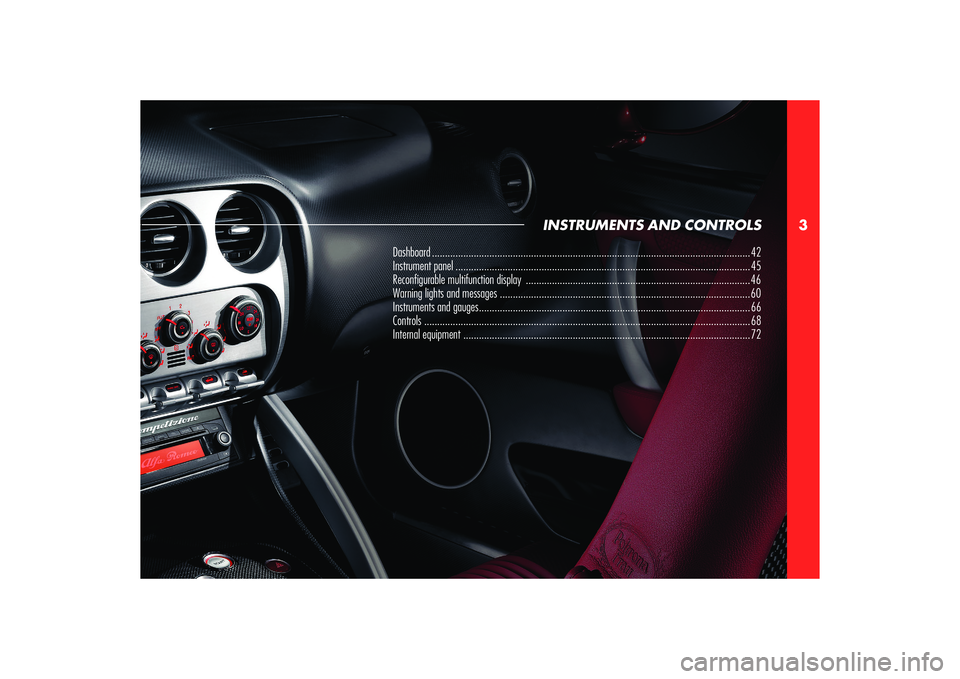
3
INSTRUMENTS AND CONTROLS
Dashboard .......................................................................................................................... 42
Instrument panel ................................................................................................................. 45
Reconfi gurable multifunction display ...................................................................................... 46
Warning lights and messages ................................................................................................ 60
Instruments and gauges ........................................................................................................66
Controls ............................................................................................................................. 68
Internal equipment .............................................................................................................. 72
Page 44 of 223
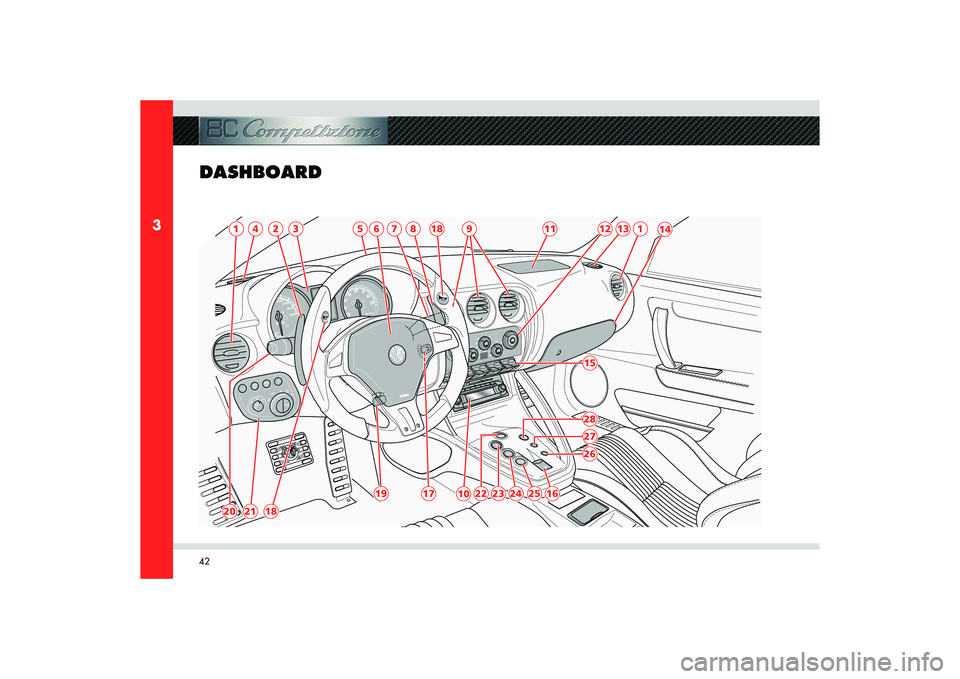
42
3
DASHBOARD
120
21
18
19
22
23
24
25
16
26272815
17
4
2
6
7
8
18
9
11
1
12
13
14
5
3
10
Page 45 of 223
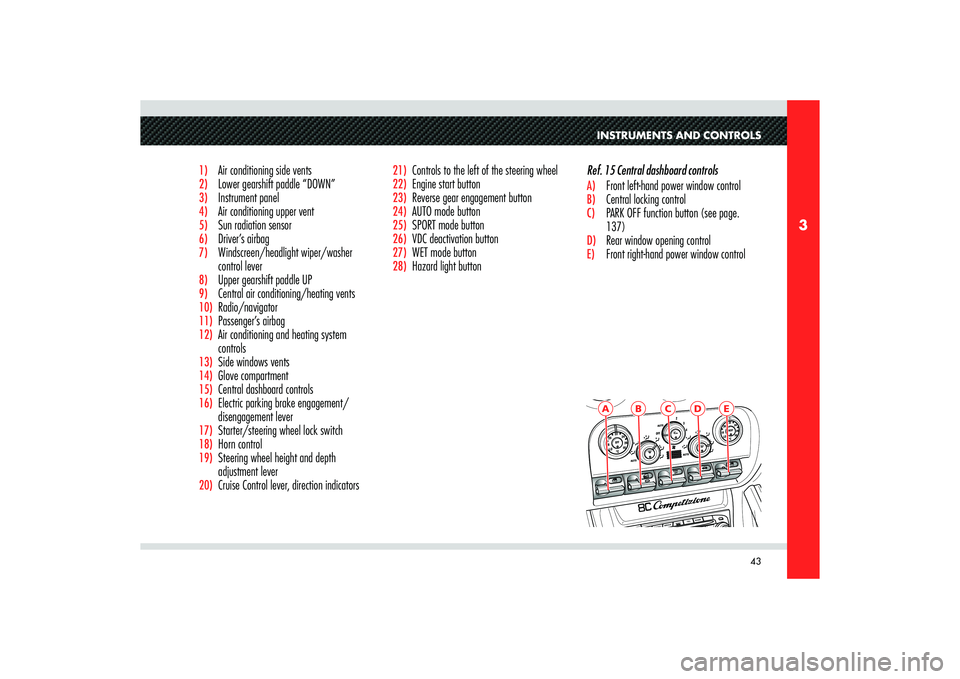
43
3
A
B
C
D
E
INSTRUMENTS AND CONTROLS
1) Air conditioning side vents2) Lower gearshift paddle “DOWN”3) Instrument panel4) Air conditioning upper vent5)
Sun radiation sensor
6)
Driver’s airbag
7)
Windscreen/headlight wiper/washer
control lever
8)
Upper gearshift paddle UP
9)
Central air conditioning/heating vents
10)
Radio/navigator
11)
Passenger’s airbag
12)
Air conditioning and heating system
controls
13)
Side windows vents
14)
Glove compartment
15)
Central dashboard controls
16)
Electric parking brake engagement/
disengagement lever
17)
Starter/steering wheel lock switch
18)
Horn control
19)
Steering wheel height and depth
adjustment lever
20)
Cruise Control lever, direction indicators
21)
Controls to the left of the steering wheel
22)
Engine start button
23)
Reverse gear engagement button
24)
AUTO mode button
25)
SPORT mode button
26)
VDC deactivation button
27)
WET mode button
28)
Hazard light buttonRef. 15 Central dashboard controls
A) Front left-hand power window controlB) Central locking control C) PARK OFF function button (see page.
137)D) Rear window opening control E) Front right-hand power window control
Page 71 of 223
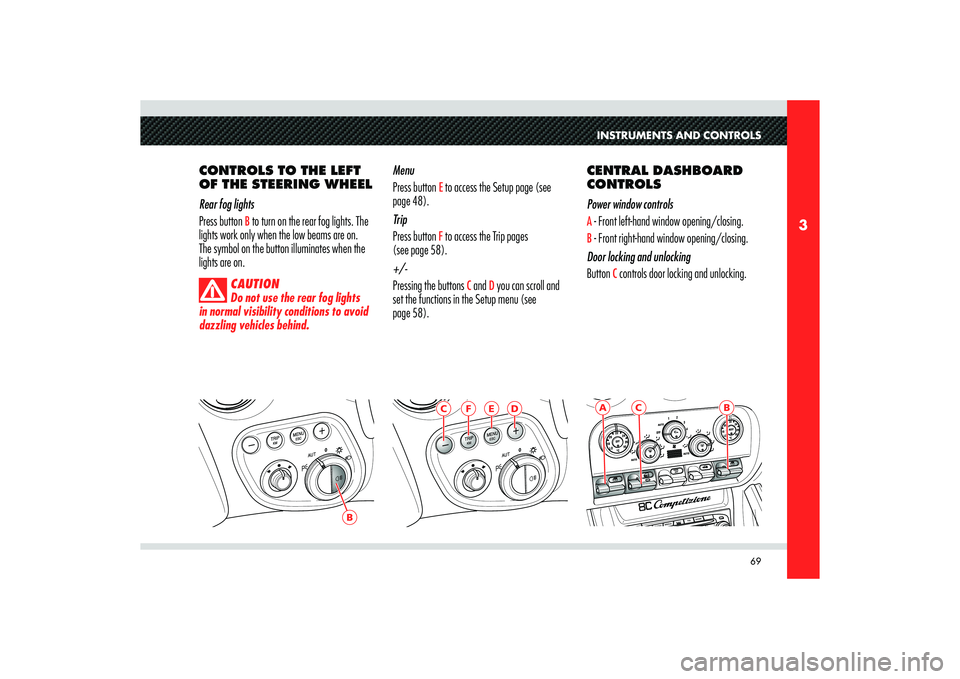
69
3
B
C
B
AINSTRUMENTS AND CONTROLS
CONTROLS TO THE LEFT
OF THE STEERING WHEEL
Rear fog lights
Press button
B to turn on the rear fog lights. The
lights work only when the low beams are on.
The symbol on the button illuminates when the
lights are on.
CAUTION
Do not use the rear fog lights
in normal visibility conditions to avoid
dazzling vehicles behind.
Menu
Press button
E to access the Setup page (see
page 48).
Trip
Press button F to access the Trip pages
(see page 58).
+/-
Pressing the buttons
C and
D you can scroll and
set the functions in the Setup menu (see
page 58).CENTRAL DASHBOARD
CONTROLS
Power window controls
A - Front left-hand window opening/closing.B - Front right-hand window opening/closing.
Door locking and unlocking
Button
C controls door locking and unlocking.
E
F
C
D